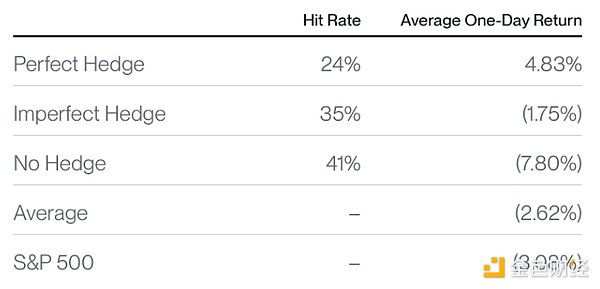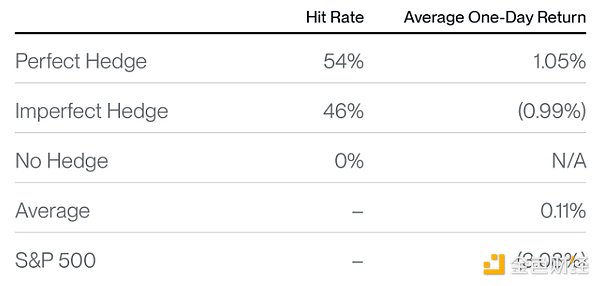Author: Juan Leon, Bitwise Senior Strategist; Compiler: 0xjs@Golden Finance
Data shows that when the stock market sells off, long-term investors may be more advantageous to flock to Bitcoin than gold.
On August 5, global stock markets fell into panic, Japan's Nikkei index fell 12%, the largest single-day drop since 1987, and the S&P 500 closed down 3%.
Unfortunately, Bitcoin's performance was not much better, plummeting 14.52% between August 2 and August 5. The sharp pullback has raised a lot of questions in the media: Why did Bitcoin fail as a hedge tool? Is Bitcoin really a hedge asset?
Out of curiosity, I decided to dig deeper into historical data.
Specifically, I analyzed the daily declines of 2% or more in the S&P 500 over the past decade and observed the reactions of Bitcoin and gold.
I then divided the returns of each asset into three categories based on how they performed on the day the S&P 500 fell:
Perfect Hedge – The asset provided a positive return
Partial Hedge – The asset generated a negative return but outperformed the S&P 500
Unhedged – The asset’s return was worse than the S&P 500
What I found was more illuminating and more nuanced than what is usually reported.
Is Bitcoin a Short-Term Hedge? Not really.
First, the bad news for Bitcoin:The data shows that Bitcoin is an unreliable short-term hedge. In fact, its one-day returns don’t seem to correlate at all with stock market movements.
More than half of the time (59% to be exact), it acted as a hedge, either rising significantly or falling less than stocks on days when the S&P 500 fell sharply. But the other 41% of the time, it fell more than the index.
Unfortunately, when that happens, it tends to be bad: when stocks fall 2% or more and Bitcoin underperforms, it really falls, falling 7.80% on average.
This tells me that not all one-day pullbacks are the same. Of course, there are different reasons why stocks fall 2% on a given day. The data suggests that some of these reasons cause Bitcoin to rise sharply and others cause Bitcoin to fall sharply; there are no hard and fast rules.
If you’re looking for a foolproof one-day hedge against a sharp stock market pullback, Bitcoin is not a good choice.
Bitcoin

Source: Bitwise Asset Management, data from Bloomberg. Data range is from January 1, 2014 to August 9, 2024.
Gold

Source: Bitwise Asset Management, with data from Bloomberg. Data range is January 1, 2014, to August 9, 2024.
Gold has performed better, although its performance has been mixed: it has achieved positive returns 54% of the time when the S&P 500 fell sharply, but on average, it has only risen 1.05% during this period. This makes gold challenging to use as an effective short-term hedge: you have to hold a lot of it to have a real impact on your overall portfolio. If 5% of your portfolio is in gold, that 1% move will do little to mitigate a pullback against the traditional 60% equity allocation in your portfolio. The other 46% of the time, gold fell an average of 0.99%, resulting in portfolio losses.
Fortunately, most of us don’t invest for one day, but for the long term. So I wondered, how do these two assets perform as long-term hedges against these one-day shocks?
Historically, has Bitcoin been a long-term hedge? Absolutely.
The performance records of these two assets over the full year tell a completely different story. In a year following a 2% or greater correction in the stock market, gold returned an average of 7.88%, lagging far behind the stock market’s rebound. However, Bitcoin’s average return is a whopping 189.68%, more than making up for its volatility.
Average one-year return after a sharp drop in the S&P 500

Source: Bitwise Asset Management, data from Bloomberg. Data range is from January 1, 2014 to August 9, 2024.
This dynamic makes sense. Gold is a trusted asset that many people instinctively buy during short-term panics. But its mature state means it underperforms over longer periods. Bitcoin, with its limited supply and reduced issuance, has strong store-of-value properties, but is still early in its adoption phase. As a result, it still has elements of a risk-on asset. This means that its single-day reaction to market pullbacks varies more, but the longer you look at it, the better the returns.
For the past decade of returns, the record is clear: when the market pulls back, buying Bitcoin pays off.
Will Bitcoin outperform again?
The easiest criticism of this analysis is that past performance is no guarantee of future performance. While this time may be different, the 12-month outlook for Bitcoin is one of the most bullish I've ever seen.
Consider the following potential catalysts:
1. Spot Bitcoin ETP Inflows:Since January, inflows into Bitcoin ETPs have exceeded $17 billion, outstripping new supply and driving Bitcoin to all-time highs earlier this year. These inflows don't even include some of the biggest players. Last week, Morgan Stanley became the first major securities firm to approve the launch of a Bitcoin ETP on its platform. We expect Merrill Lynch, UBS, Wells Fargo and others to follow suit.
2. Regulatory tailwinds:A bipartisan coalition in Congress has pushed three cryptocurrency bills through the House this year. With the Republican Party including cryptocurrency in its official 2024 platform and the Harris campaign reassessing its stance, the industry is about to usher in regulatory clarity.
3. Fed rate cuts:Central banks such as the European Central Bank and the Bank of England have already begun to cut interest rates. As slowing U.S. inflation and weak economic data raise recession concerns, the Fed must catch up. Federal funds futures already expect the Fed to cut interest rates at its September meeting.
Are we out of the woods? Probably not yet. Investors are still uneasy about market volatility caused by the unwinding of yen carry trades. Add to that the uncertainty of the U.S. presidential election, signs of a global economic slowdown and the looming threat of conflict between Iran and Israel, and there will be more turbulence ahead. But the next time stocks sell off, you'll know which asset is the best long-term hedge.
 JinseFinance
JinseFinance
 JinseFinance
JinseFinance JinseFinance
JinseFinance Catherine
Catherine Bitcoinist
Bitcoinist Bitcoinist
Bitcoinist Bitcoinist
Bitcoinist Cointelegraph
Cointelegraph 链向资讯
链向资讯 Cointelegraph
Cointelegraph 链向资讯
链向资讯